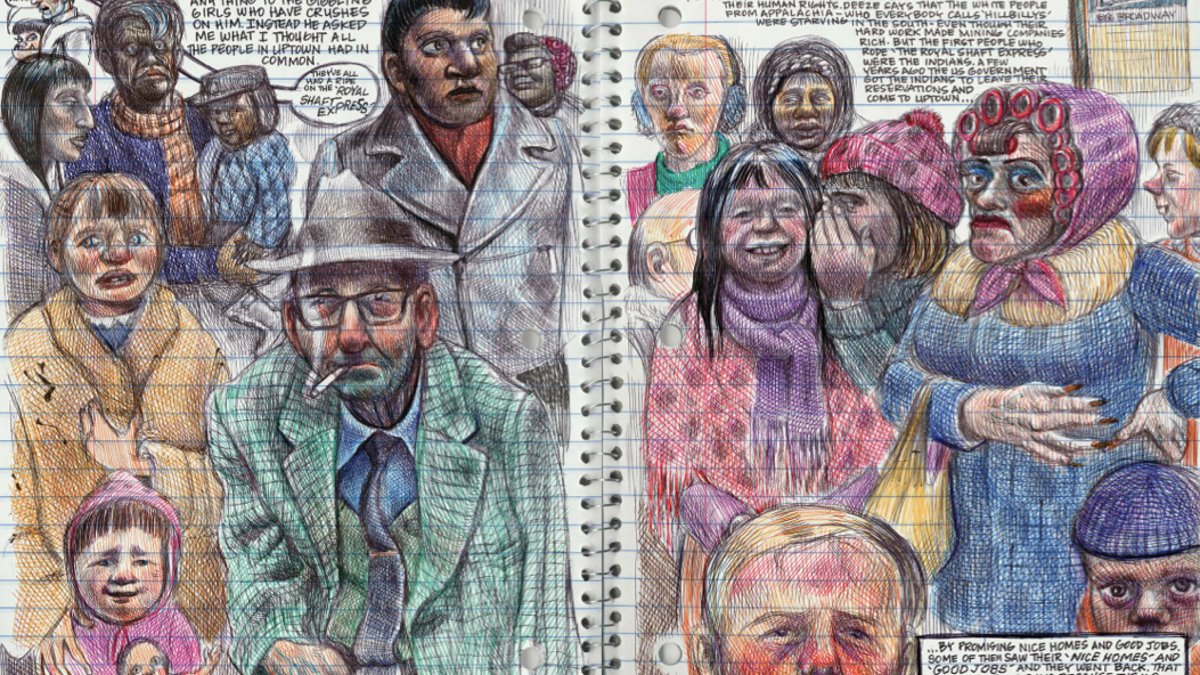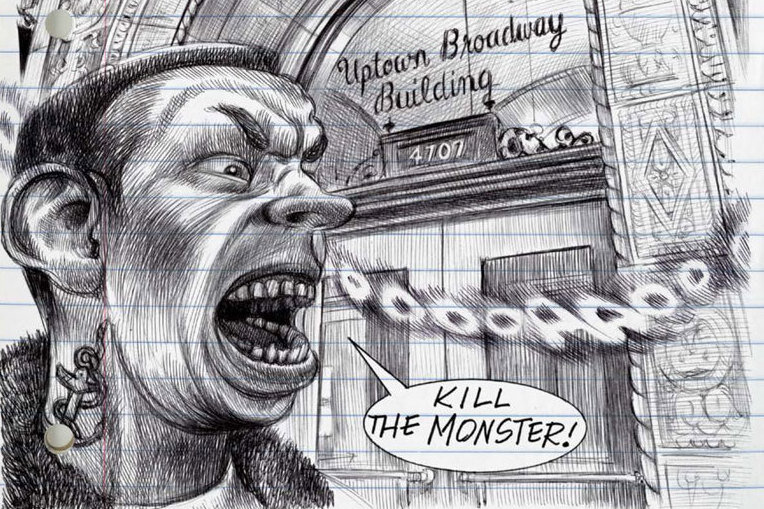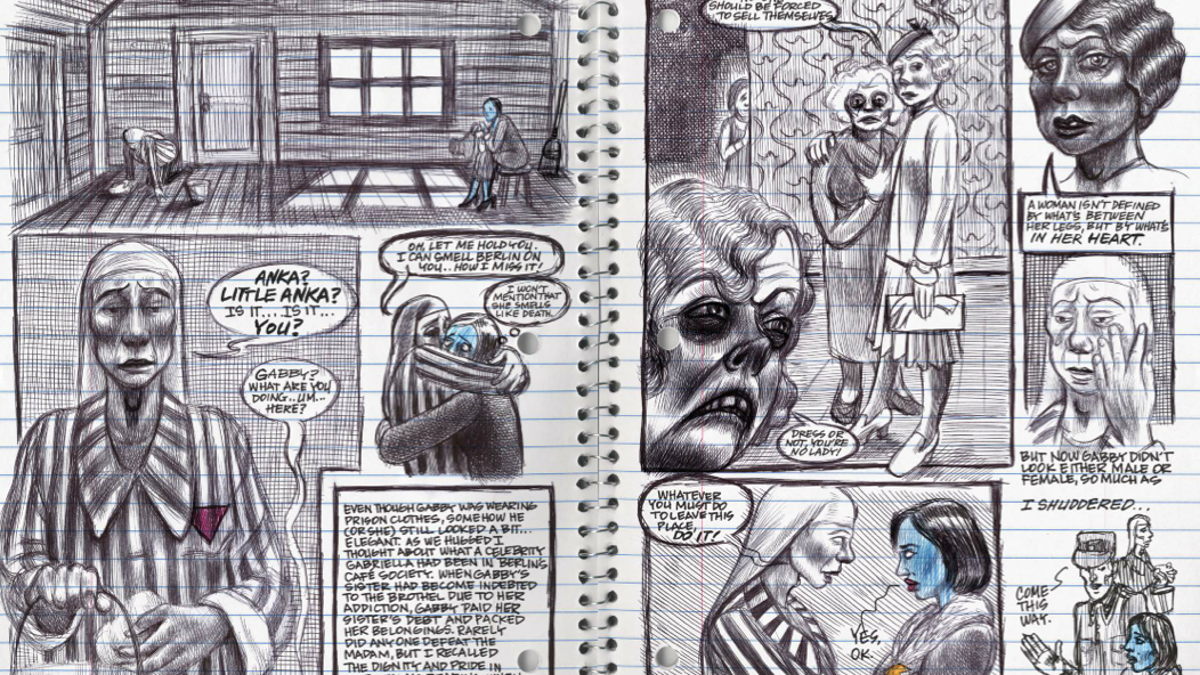
This bulky, enormous graphic novel is dense enough to knock out a mugger. Its cover, with a blue-faced woman rendered in ballpoint looking, shocked, at the viewer, intimidated me when I first saw it at the Strand. The small font inside made me worried that I wouldn’t be able to flip through it as easily as I could other new GN releases as I waited to meet my friend at the coffee shop. So I put off reading it. But I know that if it had been released four or five years ago, when I spent long afternoons at my local library or the comics store in Lacey, Washington, I would have grabbed it, settled into an uninhabited corner on the floor, and sunk into its pages. It has the right resonance to be the perfect book for a rainy afternoon, or a day when the power is out altogether. Unlike most GNs, which take between thirty minutes and an hour to read, My Favorite Thing Is Monsters will take you three hours to skim and a good six if you are trying to fully ingest it.
To get into this book, you have to acclimate yourself to its terms. Pages inside are drawn with colorful ballpoint on notebook paper, and alternate between narrative graphic novel scenes and full-page inky renderings of wolves, mobs, Frankenstein’s monsters, and city crowds.

It doesn’t look like anything else, which could be one reason Fantagraphics–known for their preference for unusual, daring work and medium-bending stylistic flair–brought it forth into the world. I finally read it, after everyone I knew assuring me for months that it was exactly my thing, that I would adore it, that it was spooky and yummy and smart and insanely complicated. I found that it is, in fact, one hell of an incredible story. Or rather, two stories– removed from each other by twenty-five years and an old tape recorder. My reference points are not everyone’s, but if I were given a tissue sample and instructed to name names, I would call it part Harriet the Spy, part noir detective novel, part war novel, part horror comic fantasia, with a heavy injection of Lynda Barry and Alison Bechdel memoir and a ridge of nodules down its spine that reeks of John Darnielle’s work concerning monster empathy and revenge.
If that doesn’t get you hooked, I would add that it has another beating heart in addition to the above: it’s also an exploration of what it feels like to be a smart, gay child, to lose a parent, to see someone like oneself alive in the distant past, and to feel like a monster.

My Favorite Thing Is Monsters is narrated by a precocious eleven-year old who draws herself as a werewolf with an underbite. Karen Reyes lives in Chicago with her Appalachian-Irish-Cherokee mother and her tattooed, artistic brother, Diego Zapata, who goes by Deez.

Karen and Deez, who are half-Mexican, are not welcome everywhere in 1968 Chicago, but their mother’s reputation as a “saint” protects them against the worst prejudice. Mama Reyes is full of superstitions and has one bright green spot in her eye, which Karen thinks of as a magic safe island.
Karen feels like she and her family are outsiders in constant danger and longs for a monster to come out of the night and bite them all so that they will be ensured protection from the mobs of boring, stupid people she feels populate the world outside outside, like the old woman who tells her brother to dance on down to the taco joint when he joins her and her mother at a diner. At school, Karen’s former best friend and love interest, Missy, has been instructed to ignore her, despite their common love of horror movies.

She feels alone, with few outlets besides her journal.

The stakes of her life get higher one morning in February, when her upstairs neighbor Anka, a Holocaust survivor who is known to be slightly mad,is found shot in the heart, and Karen begins to suspect that her family knows more than they are letting on about the murder. Anka was never Karen’s close friend– Karen knows that she loves plants, and has a garden of potted foliage on the landing that Karen sometimes hides in for fun. Karen also suspects that her brother and Anka have been sexually involved. She doesn’t initially suspect her brother of anything more serious, though she notes the alibis of everyone in the building and concludes that several people’s alibis, including her brother and mother’s, come up short.

Shortly afterwards, Karen learns a new piece of distressing news: her beloved mother has cancer. As she tries to deal with this information, she encounters Anka’s husband, Mr. Silverberg, a jazz musician devastated by the loss of his wife. After Karen overhears a woman describing Anka as a monster in the hallway, and making vague accusations about something from the past, Karen and Mr. Silverberg sit down to listen to a cassette tape recording of Anka’s memories of the Holocaust, which Mr. Silverberg says will explain everything.
The following narrative is both heavy and heady, but it is possible to follow the thread of the story while losing track of some of the details. I will say that while some of the scenes between Karen and the suspicious husband who has survived Anka test my ability to suspend disbelief, the structure of Anka’s story-within-a-story and the direct connection the text makes between the memories of the Holocaust and the carnalities and absurdity of 1960s detective and monster comics is a brilliant jump into mostly unexplored areas of cultural analysis and memory. “Karen’s” involved art depicting Anka’s memories draw visual parallels between teenage Anka and modern-day Karen, and explore Anka’s obsession with and dependence on Olympian gods as parallel to Karen’s own interest in the icons of horror movie culture. There is a tense parallel about how men’s control of female sexuality is akin to beheading Medusa; Karen frantically reproduces this fable over and over in bloody ink within the segments of story about Anka, while musing about what she knows about straight sexuality and how she is afraid of it. Art Spiegelman has praised the book, and while this is a looser translation of history than Maus, it maintains a tight emotional immediacy that hits home.

At the same time, Karen is grounded in 1960s reality, and her own elementary-school anxieties and drama. A gut-wrenching scene, for me, comes when Karen visits her ex-friend Missy’s birthday party, to which she was invited against Missy’s mother’s wishes, and she and Missy steal a long hug in the stairwell together. Missy loves vampires as much as Karen loves the Wolfman; Karen thinks she is beautiful beyond belief, though she draws her with realistically awkward long front teeth. They are blood-sisters, and Karen has established, earlier in the story, that she feels like even if Missy treats her badly at school, there is a part of her, the real part inside, that the world is trying to kill, and which it’s Karen’s job to keep alive. As they embrace, both children transform, in Karen’s mind’s eye, into a vampiric femme fatale and a hairy, brutal wolf-monster, holding onto one another in the darkness of the stairwell before Karen returns home. When, later, her brother Deez calls Karen out for always drawing herself as a wolf-man, Karen explains that it’s because she’s a lesbian. She knows, despite her age, what she wants, and feels that it is right–but she knows that other people don’t understand her desires, which makes them monstrous.

Franklin, the tall black kid from Karen’s school, knows too–which is why he protects her from bullies who are trying to beat her up under the elevated track one day before school. After she runs away, Franklin and Karen (and a young, malnourished refugee from a mining town named Sandy) spend a day at the art museum. On the way home, they discover Martin Luther King Jr has been shot. As one man tells Franklin about what happened, another comes up and begins insulting Franklin, calling him a “faggot” and telling him that he does not belong to a movement for black liberation because of his physical affect. It is only at this point in the narrative where you see that Franklin wears a fur coat and tight pants. Comments by Ferris have implied this character might be trans. I’d love it if that were true. It’s a case of implied versus stated, and Franklin gets mad at Karen and we don’t see him again, so it’s impossible to elaborate on this one. But I get a sense that Ferris is pretty cool, so my hopes are high for her intent.

I don’t really know how to elaborate here beyond what I’ve already said–my tendency is to totally spoil books by gushing about their entire plot line. I think in this case even if the spoilers are covered it’s still an exciting book, but I’m going to cut myself off before I dig my own grave.
Basically, sit down and spend time with this book. It’s so good and so interesting and juicy–a fat morsel of all the monsters we have to take in their skim-milk versions from other places. Read it with your friends and talk about it. Draw yourself as a monster. Get into journal comics and break into your neighbor’s house.
